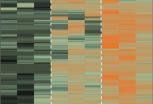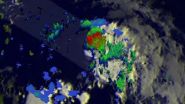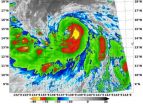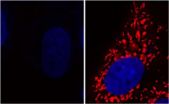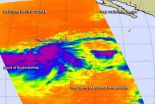(Press-News.org) Understanding eye diseases is tricky enough. Knowing what causes them at the molecular level is even more confounding.
Now, University of Iowa researchers have created the most detailed map to date of a region of the human eye long associated with blinding diseases, such as age-related macular degeneration. The high-resolution molecular map catalogs thousands of proteins in the choroid, which supplies blood and oxygen to the outer retina, itself critical in vision. By seeing differences in the abundance of proteins in different areas of the choroid, the researchers can begin to figure out which proteins may be the critical actors in vision loss and eye disease.
"This molecular map now gives us clues why certain areas of the choroid are more sensitive to certain diseases, as well as where to target therapies and why," says Vinit Mahajan, assistant professor in ophthalmology at the UI and corresponding author on the paper, published in the journal JAMA Ophthalmology. "Before this, we just didn't know what was where."
What vision specialists know is many eye diseases, including age-related macular degeneration (AMD), are caused by inflammation that damages the choroid and the accompanying cellular network known as the retinal pigment epithelium (RPE). Yet they've been vexed by the anatomy: Why does it seem that some areas of the choroid-RPE are more susceptible to disease than others, and what is happening at the molecular level? The researchers set about to answer that question with non-diseased eye tissue donated by three deceased older individuals through the Iowa Lions Eye Bank. From there, Mahajan and Jessica Skeie, a post-doctoral researcher in ophthalmology at the UI, created a map that catalogs more than 4,000 unique proteins in each of the three areas of the choroid-RPE: the fovea, macula, and the periphery.
Why that's important is now the researchers can see which proteins are more abundant in certain areas, and why. One such example is a protein known as CFH, which helps prevent a molecular cascade that can lead to AMD, much like a levee can keep flooding waters at bay. The UI researchers learned, though the map, that CFH is most abundant in the fovea. That helps, because now they know to monitor CFH abundance there; fewer numbers of the protein could mean increased risk for AMD, for instance.
"Now you can see all those differences that you couldn't see before," explains Mahajan, whose primary appointment is in the Carver College of Medicine.
Previous studies have compared the abundance of single proteins in the fovea, macula, and periphery. The UI choroid-RPE map corroborates findings from these studies, while also opening a whole, new avenue of research into thousands of proteins that may be involved in vision loss. Mahajan likens it to a leap from the first topological drawings of a landscape to the detailed satellite images we have now.
"We were able to identify thousands of proteins simultaneously and develop a map that shows what are the patterns of proteins that make these regions unique. This has helped explain why certain genes are associated with macular degeneration, and helps point us to new treatment targets," says Skeie, who earned her undergraduate and master's degrees at the UI and is the study's first author.
INFORMATION:
The work was funded by the Bright Focus Foundation, a nonprofit organization whose mission is to eradicate brain and eye diseases, including Alzheimer's disease, macular degeneration, and glaucoma.
Skeie, who grew up in Cedar Rapids, helped design the study and performed research. She, like Mahajan, are supported through grants from the National Institutes of Health (grants numbers: 1F32EY022280 and K08EY020530)
A map for eye disease
University of Iowa researchers create most detailed molecular map of eye region associated with vision loss
2014-08-01
ELSE PRESS RELEASES FROM THIS DATE:
NASA finds heavy rainfall and wind shear in newborn Tropical Storm Bertha
2014-08-01
VIDEO:
This 3-D flyby of Tropical Storm Bertha on Aug. 1 was created from TRMM satellite data. It shows (from the south) intense thunderstorms were reaching heights of over 15km (about...
Click here for more information.
The Tropical Rainfall Measuring Mission satellite known as TRMM found rain was falling heavily in the Atlantic Ocean's second tropical storm of the hurricane season. Bertha was close to the Lesser Antilles, prompting warnings and watches.
The National Hurricane ...
Reptile Database surpasses 10,000 reptile species
2014-08-01
More than 10,000 reptile species have been recorded into the Reptile Database, a web-based catalogue of all living reptile species and classification, making the reptile species among the most diverse vertebrate groups in the world, alongside bird and fish species.
For some time, experts have projected that 2014 would mark the year that reptiles would become the most diverse vertebrate group in the world. Reptiles include snakes, lizards, turtles, crocodiles, tuataras and amphisbaenians.
"Officially, we have logged 10,038 reptile species into the database, which is ...
NASA sees Tropical Storm Halong's 'best side'
2014-08-01
NASA satellite data showed Tropical Storm Halong's "best side" or most powerful side was east of its center. That's where the coldest cloud top temperatures and strongest thunderstorms appeared on satellite imagery.
On August 1 at 13:30 UTC (9:30 a.m. EDT) the Moderate Resolution Imaging Spectroradiometer or MODIS instrument aboard NASA's Terra satellite captured an infrared picture of Tropical Storm Halong. The infrared data showed the coldest, strongest thunderstorm cloud-top temperatures east of the center of circulation. Cloud tops were as cold as -80F/-62C. Cloud ...
Advances in assisted reproduction create more options & new legal issues for LGBT couples
2014-08-01
New Rochelle, NY, August 1, 2014—Lesbian, gay, bisexual, and transgender individuals who want to conceive a child may face the same problems as some of their heterosexual and cisgendered peers, such as reduced fertility, but in addition they often face additional physiological and legal challenges to become parents. A comprehensive review of the most recent advances in assisted reproduction options is presented in the article "LGBT Assisted Reproduction: Current Practice and Future Possibilities," published in LGBT Health, a peer-reviewed journal from Mary Ann Liebert, ...
Scientists name new species of cetacean: The Australian humpback dolphin
2014-08-01
Scientists examining a taxonomically confused group of marine mammals have officially named a species new to science: the Australian humpback dolphin, Sousa sahulensis, according to the Wildlife Conservation Society and Clymene Enterprises.
The study describing the newly named species is the culmination of a 17-year long systematic examination of all available historical records, physical descriptions, and genetic data of humpback dolphins—a widespread group of coastal cetaceans ranging from the coast of West Africa to the northern coast of Australia. The Australian ...
Electronic reminders can help patients prevent surgical site infections
2014-08-01
CHICAGO (August 1, 2014)—The use of electronic reminders such as text messages, emails or voicemails is highly effective at getting surgical patients to adhere to a preadmission antiseptic showering regimen known to help reduce risk of surgical site infections (SSIs), according to a first-of-its-kind study published in the August issue of the Journal of the American College of Surgeons.
Each year approximately 400,000 SSIs occur and lead to a death rate approaching nearly 100,000 according to data sources cited by study authors. To help reduce the risk of these dangerous ...
Potential treatment and prevention of Parkinson's disease
2014-08-01
This news release is available in German.
Parkinson's disease affects neurons in the Substantia nigra brain region – their mitochondrial activity ceases and the cells die. Researchers at the Max Planck Institute of Molecular Cell Biology and Genetics show that supplying D-lactate or glycolate, two products of the gene DJ-1, can stop and even counteract this process: Adding the substances to cultured HeLa cells and to cells of the nematode C. elegans restored the activity of mitochondria and prevented the degeneration of neurons. They also showed that the two substances ...
NASA eyes powerful bands of thunderstorms in newborn Tropical Storm Iselle
2014-08-01
Tropical Storm Iselle was born in the Eastern Pacific Ocean soon after NASA's Aqua satellite gathered infrared imagery on the storm that showed powerful thunderstorms wrapping into developing storm's center. Iselle is not close enough to land to cause any watches or warnings.
The Atmospheric Infrared Sounder or AIRS instrument aboard NASA's Aqua satellite passed over System 95E on July 31 at 5:23 p.m. EDT from gathered infrared data before it became Tropical Storm Iselle. The data was made into a false-colored image at NASA's Jet Propulsion Laboratory in Pasadena, California. ...
Heavy metals and hydroelectricity
2014-08-01
Boulder, Colorado, USA – Hydraulic engineering is increasingly relied on for hydroelectricity generation. However, redirecting stream flow can yield unintended consequences. In the August 2014 issue of GSA Today, Donald Rodbell of Union College-Schenectady and coauthors from the U.S. and Peru document the wholesale contamination of the Lake Junín National Reserve by acid mine drainage from the Cerro de Pasco mining district.
According to the World Bank, about 60% of Peru's electricity is generated by hydropower, which during the dry season relies heavily on glacial meltwater ...
Scripps Research Institute scientists find new calorie-burning switch in brown fat
2014-08-01
LA JOLLA, CA—August 1, 2014—Biologists at The Scripps Research Institute (TSRI) have identified a signaling pathway that switches on a powerful calorie-burning process in brown fat cells.
The study, which is reported in this week's online Early Edition of the Proceedings of the National Academy of Sciences, sheds light on a process known as "brown fat thermogenesis," which is of great interest to medical researchers because it naturally stimulates weight loss and may also protect against diabetes.
"This finding offers new possibilities for the therapeutic activation ...
LAST 30 PRESS RELEASES:
Making lighter work of calculating fluid and heat flow
Normalizing blood sugar can halve heart attack risk
Lowering blood sugar cuts heart attack risk in people with prediabetes
Study links genetic variants to risk of blinding eye disease in premature infants
Non-opioid ‘pain sponge’ therapy halts cartilage degeneration and relieves chronic pain
AI can pick up cultural values by mimicking how kids learn
China’s ecological redlines offer fast track to 30 x 30 global conservation goal
Invisible indoor threats: emerging household contaminants and their growing risks to human health
Adding antibody treatment to chemo boosts outcomes for children with rare cancer
Germline pathogenic variants among women without a history of breast cancer
Tanning beds triple melanoma risk, potentially causing broad DNA damage
Unique bond identified as key to viral infection speed
Indoor tanning makes youthful skin much older on a genetic level
Mouse model sheds new light on the causes and potential solutions to human GI problems linked to muscular dystrophy
The Journal of Nuclear Medicine ahead-of-print tip sheet: December 12, 2025
Smarter tools for peering into the microscopic world
Applications open for funding to conduct research in the Kinsey Institute archives
Global measure underestimates the severity of food insecurity
Child survivors of critical illness are missing out on timely follow up care
Risk-based vs annual breast cancer screening / the WISDOM randomized clinical trial
University of Toronto launches Electric Vehicle Innovation Ontario to accelerate advanced EV technologies and build Canada’s innovation advantage
Early relapse predicts poor outcomes in aggressive blood cancer
American College of Lifestyle Medicine applauds two CMS models aligned with lifestyle medicine practice and reimbursement
Clinical trial finds cannabis use not a barrier to quitting nicotine vaping
Supplemental nutrition assistance program policies and food insecurity
Switching immune cells to “night mode” could limit damage after a heart attack, study suggests
URI-based Global RIghts Project report spotlights continued troubling trends in worldwide inhumane treatment
Neutrophils are less aggressive at night, explaining why nighttime heart attacks cause less damage than daytime events
Menopausal hormone therapy may not pose breast cancer risk for women with BRCA mutations
Mobile health tool may improve quality of life for adolescent and young adult breast cancer survivors
[Press-News.org] A map for eye diseaseUniversity of Iowa researchers create most detailed molecular map of eye region associated with vision loss
